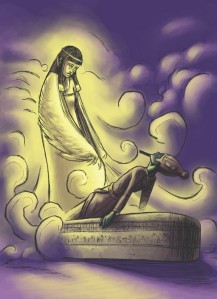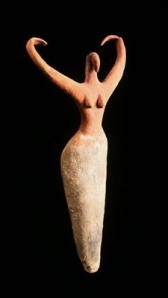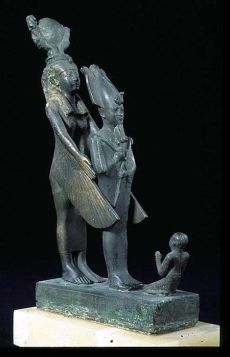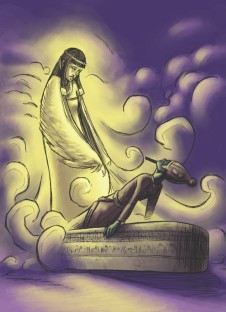This is a longish post because I found out some things I didn’t know about the Kite, the Kites, and Isis and Nephthys as the Kites. I’ll bet you’ll find out something you didn’t know, too.
Now, what you may already know is that the most consistent avian form that Isis and Nephthys take is the black kite. Black kites are birds of prey. They eat carrion and they hunt live prey. And one of the things I just learned is why they are called “kites.” It’s from their characteristic hunting technique in which they hover over the prey (like a paper kite does at the end of its string) and then do a swift dive to capture it. This highly successful hunting move is called “kiting.”
So today, we’re looking into the Kites, especially (but not exclusively) the Divine Kites, the Goddess Kites. We often see Them as Isis and Nephthys at the head and foot of Osiris’ mummy bier. Sometimes They are in Their bird form, sometimes fully anthropomorphic, and sometimes combining the two forms as women with wings.
In other images, we see Isis as a kite hovering (kiting!) over the erect phallus of a mummyform Osiris in order to conceive Their child Horus. We also find the Kite/s in funerary processions and in the Opening of the Mouth ritual. The Opening of the Mouth is a funerary rite; its main purpose is enlivening. It was used to give life or renewed life to everyone and everything from the mummified king to the sacred statues and images in a temple.
Egyptologist Racheli Shalomi-Hen notes that the first appearance of a Kite or Kites is in depictions of non-royal funerary processions of the late 5th dynasty of Egypt’s Old Kingdom. We know who the Kites are in these depictions because they are labeled. In Egyptian, Kite is Djeret while the Two Kites are the Djereti.
Egyptologists usually group the Kite/s in with other professional mourners (as opposed to mourners from the family of the deceased). This is probably because, once the Kites were connected with Isis and Nephthys, They were mourning Osiris. But the Kites seem to have other functions as well.
If the Kites were professionals, it must mean that their roles required special knowledge and skills. Just speculating here, but I wonder whether they were specialized priestesses of some kind. (As an aside, the Kites were also associated with another special funerary ritualist, the Demdjet. You can read about the Demdjet here.)
Shalomi-Hen suggests that the appearance of the Kite/s in these non-royal tombs is an indication that the non-royal dead were already identified with Osiris by that time—earlier that usually thought. At that time, she says, the Kites were not associated with the Goddesses; they were human funerary ritualists.

She proposes that it was only after the king wanted to be an Osiris, too, that the Kites gained Divine and mythological status—and that this was done for the first time in the Pyramid Texts.
Other Egyptologists think that the basic Egyptian myth cycles, including the Osirian, may have been formed as early as the 2nd or 3rd dynasties—though we have nothing of length written down until the Pyramid Texts.
I’m not convinced that the Osirian myth we find in the Pyramid Texts represents the first time that this myth cycle was formulated. In the Pyramid Texts, we already see the characteristic mythological allusions that assume that scribes and educated readers (such as the priesthood concerned with funerary rites) would understand the reference to the whole myth from just the allusion. If this were the first time the myth was formulated, they would not have been able to do so. Instead, this must mean that—even before such allusions were written down in the Pyramid Texts—there was an oral tradition, and that is where the Osirian cycle first emerged.
In the illustration from one of these non-royal funerals (above), you can see that there isn’t anything particularly bird-like in the Kite’s dress or implements; indeed she has no implements and wears only the usual Old Kingdom sheath dress. Yet she is called the Kite. What then is the connection between the black kite and funeral rites?
Some scholars have suggested that the cry of the black kite may have sounded to the Egyptians like mourning women. I’ve listened to a number of recordings of black kite calls and…maybe? The closest one I’ve found is the warbling call in the last part of this video. The wavering cry sounds vaguely mournful. On the other hand, the kite also has a sharp cry, which caused another Egyptologist to suggest that the kite’s cry might have been thought to wake the dead. Yet another offers that the kite’s participation in funerals may have developed from a prehistoric hunting ritual. I wanted to look into that a bit, so I dug up that article.
In it, Egyptologist Eberhard Otto notes that the Kite is also present in some versions of the Opening of the Mouth ritual—in the part where the foreleg of the bull/bull calf is being cut off and its heart cut out. Sometimes, this female ritualist is identified simply as the Kite or the Great Kite. Sometimes there are two ritualists, the Great Kite and the Small Kite, Who later were identified with Isis and Nephthys.
In versions of the ritual where the Kite is present, she/She whispers into the ear of the sacrificial animal, blaming it for its own death. She says, “Your two lips have done that against you.”
Egyptologist Maria Valdesogo Martín identifies the Kite in the New Kingdom scene from the Opening of the Mouth shown here specifically as a mourner. This would be consistent with the well-known functions of the Kite at that time—as well as with the identification of the Great Kite as Isis. And mourning the slain animal is certainly an improvement over victim-blaming.
Nonetheless, this incident did remind me of the myth of the Contendings of Horus and Set in which Isis, in disguise as a maiden-in-distress, tricks Set into admitting that Osiris’ kingdom should go to Horus. Significantly, She first transforms into a kite, then flies into a tree and screeches, “Ha! Your own words have condemned You!”
Otto thinks that the Opening of the Mouth scene with the Kite is the part that may have originated in a prehistoric hunting ritual. He says the Kite is a later representation of a wild kite circling the body of a slain animal. The shrieking cries of the bird may have been interpreted as speech—which in later periods developed into the Kite blaming the animal for its death and, eventually, to mourning.
We begin to see Two Kites rather than just one in depictions of private funerary processions during the 5th dynasty, with most in the 6th dynasty. In the Pyramid Texts of the 5th and 6th dynasties, decidedly royal texts, we learn that the “Djereti of Osiris,” Who can only be Isis and Nephthys, “remove the ill” from the king as part of the preparation for his ascent to the heavens. In other words, They purify the king. What the Kites are removing is said to be poison, which is envisioned as venom from the fangs of a serpent that pours into the ground as the Kites supervise the action.
The Kites also help ferry the deceased king, as Osiris, “across the Winding Waterway” to the Horizon (Akhet) and rebirth. In tomb chapels of the same period as the Pyramid Texts, Kites are shown at the bow and stern of a boat that carries the coffin. We know that they/They are mourning for they/They make known mourning gestures in some cases and protective gestures in others. In these tomb chapels, the Djereti may or may not be identified as Isis and Nephthys.
We also find the Djereti represented on model boats since the Kites ferry the dead to rebirth. And here’s something really interesting.
One model boat from the Middle Kingdom includes the names of the Goddesses preceding what seem to be personal names. We see “the Nephthys Hotep-Hathor, justified” and “the Isis Hetpet, justified.” When a human name is followed by maakheru or “justified,” it means that the person is dead and has passed the judgment of Osiris. Perhaps what we are seeing here is previously deceased female relatives of the newly dead person serving as Isis and Nephthys for the deceased to help their loved one cross the Winding Waterway to rebirth.
In addition, the Kites were sometimes connected with the mummy wrappings. The Goddess of Weaving, Tayet, is sometimes identified as a Kite. Isis and Nephthys, known as the Two Weavers, are also Weaving Goddesses. There are a few Old Kingdom reliefs and paintings that show pairs of women labeled as Kites carrying boxes of offerings on their heads. In one example, we learn that they are “bringing khenit-cloth.” Khenit means “yellow” and yellow is the same as gold in Egyptian color symbolism. Thus, this cloth is solar and refers to the daily solar resurrection. Here again, we have the Kites assisting in rebirth. These cloth-bringing Djereti also sometimes have personal names attached to them, indicating that they are human Kites.
By removing poisons, attending to the mummy wrappings, and bringing offerings of yellow cloth, the Kites surely were part of the magical and physical preparation of the body and the tomb, just as female relatives were and are in so many societies, ancient and modern. Perhaps the professional Kites even guided or assisted the relatives of the deceased in these tasks.
Yet so far—with the exception of the kite’s cry interpreted as speech to the sacrificial victim or the possibility that their raptor-cries sounded like mourning—there doesn’t seem to be anything very kite-like or bird-like in the funerary function of the Kites.
But then there are those wings. Those bird wings, those kite wings.
The wings of Isis and Nephthys are Their most obvious avian attributes. As birds, the Kites fly; as birds of prey, They hunt.
As far back as the Pyramid Texts, the Two Sisters are the ones Who seek—or hunt for—Their missing brother Osiris. Their wings give Them the power to search a vast territory in a shorter period of time. Their lofty vantage point and sharp birds-of-prey vision make Them successful in their hunt.
In the Pyramid Texts, Osiris has not been dismembered, only killed. Yet when His dismemberment does become part of the myth, it isn’t much of a stretch to imagine the carrion-bird Sisters scavenging for the parts of the God’s body to re-assemble Him and make Him whole.
In the Hymn to Osiris in the Book of the Dead, Isis uses Her wings to revive Osiris enough so that She can conceive Their child and heir. “She made light with Her feathers, She created air with Her wings, and She uttered the death wail for Her brother. She raised up the inactive members of Him whose heart was still, She drew from Him His essence, She made an heir…” the text tells us.
In Egyptian lore, wings are also protective. Many are the Goddesses, wings outspread, Who protect tombs, sarcophagi, doorways, and temples. There are also a number of surviving statues of a larger Isis with a smaller image of Osiris protected between Her wings.
I remain on the lookout for more about the Kite Goddesses (as well as the human Kites). But for now we can know that Their wings are protective, Their cry can be mournful or accusatory, Their wings and vision make Them successful hunters and searchers, They can purify and prepare the dead for resurrection, and They can help “ferry” the dead toward the Horizon of Rebirth.



































